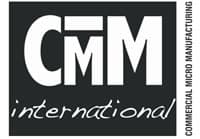
Commercial Micro Manufacturing International - August 2018
Negative-stiffness vibration isolation is
gaining popularity as a preferred solution
for nanotechnology applications
in academia and industry
DR. DAVID L. PLATUS, INVENTOR OF NEGATIVE-STIFFNESS VIBRATION ISOLATORS AND PRESIDENT AND FOUNDER OF MINUS K TECHNOLOGY
It was not so long ago that making the decision where to locate a scanning probe microscope (SPM) was a simple one; put it in the basement where the ambient vibration is minimized. Although recently, with nanotechnology applications growing exponentially, scientists and engineers are putting their equipment in a multitude of locations where vibration noise is significantly high. SPMs, interferometers and stylus profilers are being sited in locations that pose a serious challenge to vibration isolation.
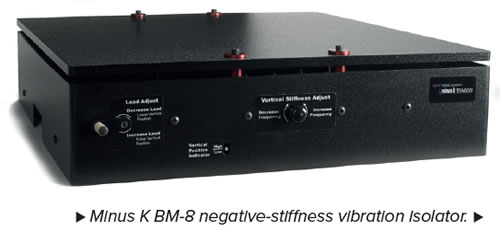 Furthermore, in an attempt to keep costs as low as possible, many academics and industry professionals are not adequately providing for vibration isolation on the ultra-sensitive nano-equipment being installed at their facilities. Although high-budget installations (valued in the hundreds of-thousands of dollars) typically incorporate adequate vibration isolation, this is not the case with many lesser-budget set-ups (those spending under US$120,000 on equipment), which represents the area of most rapid growth in the nanotechnology universe. It is estimated that 40–50 percent of these sites, in both academia and industry, are initiated with inadequate vibration isolation.
Furthermore, in an attempt to keep costs as low as possible, many academics and industry professionals are not adequately providing for vibration isolation on the ultra-sensitive nano-equipment being installed at their facilities. Although high-budget installations (valued in the hundreds of-thousands of dollars) typically incorporate adequate vibration isolation, this is not the case with many lesser-budget set-ups (those spending under US$120,000 on equipment), which represents the area of most rapid growth in the nanotechnology universe. It is estimated that 40–50 percent of these sites, in both academia and industry, are initiated with inadequate vibration isolation.
This is influenced to some degree by the fact that those specifying nano-equipment do not always fully grasp its extreme sensitivity and that proper site selection and vibration isolation is required. Any type of microscope—even a high powered optical microscope—or other nano-level instrument must be insulated against noise, otherwise images appear diffused and fuzzy or sometimes not at all.
Vibration isolators are one of those necessities that people are not really focused on at the time of purchasing an instrument such as an atomic force microscope (AFM),” explained George McMurtry, CEO of NanoAndMore USA, a supplier of AFM probes, tips and cantilevers.
But it is different for bigger scanning electron microscopes (SEMs) and transmission electron microscopes (TEMs) because these are very expensive pieces of equipment that technically require all sorts of isolation in order to work properly. Then, they are more apt to talk about it up front.”
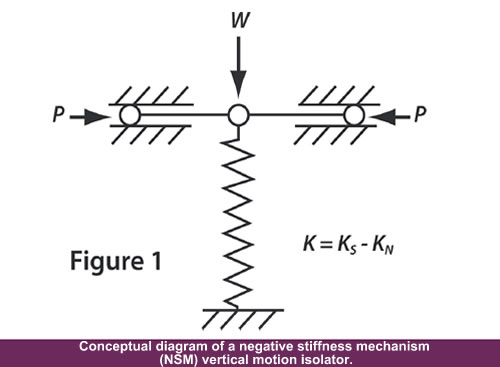
McMurtry continued: “When you get into the smaller instruments such as atomic force microscopes, white light interferometers, laser interferometers and stylus profilers, then you encounter problems with site preparation. In many cases, not a lot of site preparation is carried out, despite the fact that these instruments may be sitting on the fourth floor of a building and, without isolation, will end up producing really poor images.
"Clients often ask us what probe will solve a specific problem that they are experiencing. Sometimes no probe is going to solve their problem, as they first have to solve their noise issue, and that means looking at some sort of mechanical isolation.”
As instrumentation becomes more and more complex, and measurements become smaller and smaller, those vibrations that are present start to dominate, and the need for more effective isolation increases. Isolators have been used since the beginning with AFMs in the 1980s, but there were not that many AFMs around back then and most of them were in basements. The use of nano-instrumentation has grown dramatically, and the need for increased isolation has followed this trend.
"There are so many more people using AFMs in so many different environments that isolators are needed more often,” confirmed Mark Flowers, president of Nanoscience Instruments, a supplier of micro- and nano-scale metrology tools. “In the early days, you put your AFM in the basement but now people want to use them on the upper floors.
The basement is a much better environment for AFMs and one in which they could get by with an unsophisticated isolator.”Flowers continued: “In many instances, the consumer is unaware of the need for isolation.
We discuss with them the type of environment the equipment will be going into and what applications they are going after, before determining what they will need in an isolator. We are seeing huge growth in the education market; there are a lot of initiatives out there to expose undergraduates and high school students to nanotechnology, but they don’t necessarily know what they need to sustain proper isolation.”
The vibrations are usually very subtle. For example, they cannot be felt through the hands or feet but cause considerable noise and disturbance for an AFM or interferometer.
Vibrations are attributable to a multitude of factors, they do not originate from just one place. Buildings themselves are constantly vibrating and therefore emitting noise. The intensity of these vibrations varies depending on how old the building is and how high up off the ground the equipment is located.
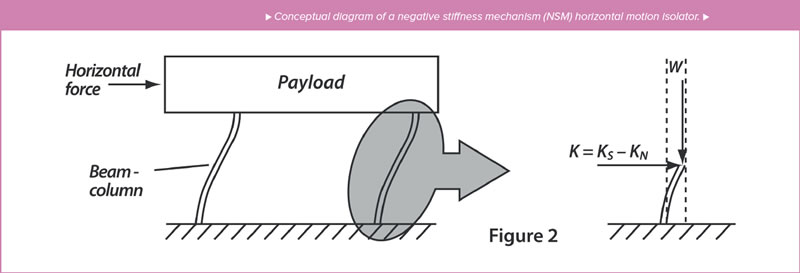
"As instrumentation becomes more and more complex, and measurements become smaller and smaller, those vibrations that are present start to dominate, and the need for more effective isolation increases"
Then there are those factors inside the building, for example, heating and ventilation systems, fans, pumps that are not properly isolated, and elevators. These mechanical devices are responsible for a tremendous amount of vibration and depending on how far away the instruments are located from them, they may or may not be adversely affected.
Finally, consideration must also be given to those factors external to the building, such as adjacent traffic, construction and the weather. For example, a breeze causes a small amount of movement, but the sway of the breeze alone measures around 2 Hz and can cause substantial resonance. A train near the building causes movement in the cement slab, nothing visible to the naked eye or indeed that can be felt, but it has disastrous consequences for instrumentation purposes. These internal and external influences cause lower frequency vibrations, raising havoc with nano-instrumentation.
Imagine trying to measure just a few angstroms or nanometers of displacement using an instrument on a surface that is not completely stable. Any vibrations transferred to the mechanical structure of the instrument causes vertical noise and, fundamentally, results in an inability to measure these kinds of high-resolution features.
A vibration isolator is used to solve the problem, but how bad the problem is will determine the type of isolator required. Air tables have been used since the 1960s. They are basically cans of air and remain the most popular isolators. However, air tables offer resonant frequencies of 2 to 2.5 Hz and can therefore typically only handle vibrations down to around 8 to 10 Hz, not quite low enough for optimum performance on modern nano-level equipment. For purposes of clarity on interferometers and SPMs, air tables are an inefficient isolation solution. They were adequate until a decade ago when better isolation became a requirement.
Readers may recall that during the early years of nanotechnology, research scientists took to suspending their very expensive AFMs from bungee cords hanging from the ceiling as a means of sustaining acceptable vibration isolation. Although some are still employing this technique, their numbers are dwindling; the majority are not willing to run the risk of poor imaging and data sets and have therefore switched to using reputable vibration isolation systems.
One such system is active isolation, also known as electronic force cancellation. Active isolation uses electronics to sense the motion, and then puts in equal amounts of motion electronically to compensate, effectively cancelling out the motion. Their efficiency is fine for the latest nanotechnology applications because they can start isolating as low as 0.7 Hz, so quite sufficient for isolating the lower frequencies that are so damaging to image clarity with SPMs and interferometers.
However, if instrumentation can be mechanically isolated but not have to rely on electricity, this is one less restriction that needs to be considered in the vibration isolation equation. Indeed, the negative-stiffness system has become a popular choice for this very reason. It is not only a highly workable solution but provides the location flexibility and portability that other vibration isolation systems do not.
Negative-stiffness isolators afford a passive approach for achieving low vibration environments and isolation against sub-Hz vibrations. They enable vibration-sensitive instruments such as micro-hardness testers, SEMs and SPMs to operate in severe vibration environments such as upper floors of buildings and cleanrooms. The images and data produced are many times better than those achievable with pneumatic isolators.
Negative-stiffness isolators are based on a unique and completely mechanical concept in low-frequency vibration isolation and comprise both a negative-stiffness mechanism (NSM) vertical-motion isolator and an NSM horizontal-motion isolator. A stiff spring that supports a weight load is combined with an NSM to form the vertical-motion isolator. The net vertical stiffness is made very low without affecting the static load supporting capability of the spring. Beam-columns are connected in series with the vertical-motion isolator to form the horizontal-motion isolator.
The horizontal stiffness of the beam-columns is reduced by the beam-column effect. A beam-column behaves as a spring when combined with an NSM. The result is a compact passive isolator capable of very low vertical and horizontal natural frequencies and very high internal structural frequencies.
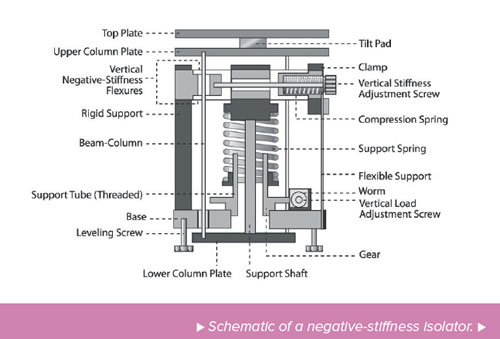
"What negative-stiffness isolators provide is really quite unique to the field of nanotechnology. Transmissibility is substantially improved over air or active isolation systems."
"Improved vibration isolation directly correlates with improved instrument performance,” stated Patrick O’Hara, former president and CEO of Ambios Technology, a manufacturer of SPMs, stylus profilers and optical interferometers used in nanotechnology (since acquired by KLA-Tencor). “When you are trying to measure atomic-scale features, mechanically stable support structures are critically important. Up until the advent of probe microscopes, and some of the other very high-resolution imaging and data acquisition techniques, air isolators were adequate for most applications, but they are not any longer.”
O’Hara continued: “What negative-stiffness isolators provide is really quite unique to the field of nanotechnology. In particular, I am referring to their transmissibility. That is the vibration that transmits through the isolator as measured as a function of floor vibrations. Transmissibility is substantially improved over air or active isolation systems.”
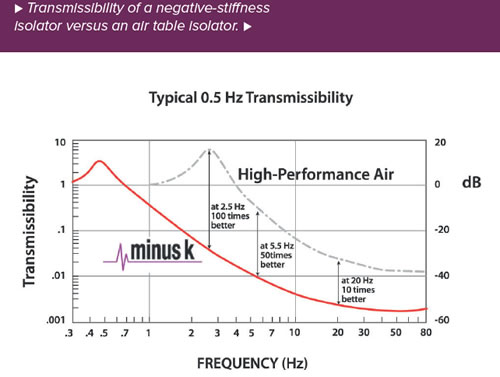
"What negative-stiffness isolators provide is really quite unique to the field of nanotechnology. In particular, I am referring to their transmissibility. That is the vibration that transmits through the isolator as measured as a function of floor vibrations. Transmissibility is substantially improved over air or active isolation systems."
Negative-stiffness isolators resonate at 0.5 Hz. At this frequency, there is almost no energy present. It would be very unusual to find a significant vibration at 0.5 Hz. Vibrations with frequencies above 0.7 Hz (where negative-stiffness isolators begin isolating) are rapidly attenuated with increases in frequency. Air isolators can make vibration isolation problems worse, since they have a resonant frequency that can match that of floor vibrations.
When adjusted to 0.5 Hz, negative-stiffness isolators achieve approximately 93 percent isolation efficiency at 2 Hz, 99 percent at 5 Hz and 99.7 percent at 10 Hz.
Advances in vibration isolation have permitted manufacturing and research to achieve levels of precision not possible earlier when pneumatic isolation was the only option. Both active and negative-stiffness vibration isolation systems have evolved over the last 20 years and now enable precision instrumentation to function at nanolevels with unpresented accuracy.
Minus K Technology
www.minusk.com